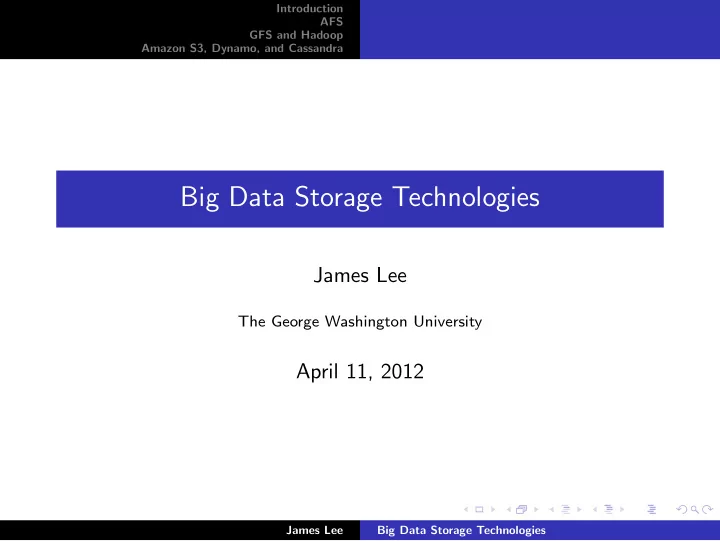

Introduction AFS GFS and Hadoop Amazon S3, Dynamo, and Cassandra Big Data Storage Technologies James Lee The George Washington University April 11, 2012 James Lee Big Data Storage Technologies
Introduction AFS GFS and Hadoop Amazon S3, Dynamo, and Cassandra What is Big Data? ◮ When the size of the data grows to become as big of a problem to store and process as the problem you are trying to solve with the data. James Lee Big Data Storage Technologies
Introduction AFS GFS and Hadoop Amazon S3, Dynamo, and Cassandra Why are traditional filesystem insufficient? ◮ Upper limit on filesystem size ◮ Limited redundancy ◮ Limited bandwidth James Lee Big Data Storage Technologies
Introduction AFS GFS and Hadoop Amazon S3, Dynamo, and Cassandra So what are the options for scaling out? ◮ Depends on business needs. ◮ Scale within a rack, within a datacenter, or across wide-area networks. ◮ Several different technologies available for achieving those goals. ◮ May have to make compromises in places. James Lee Big Data Storage Technologies
Introduction AFS GFS and Hadoop Amazon S3, Dynamo, and Cassandra Andrew File System ◮ Distributed filesystem developed in 1980s. ◮ Used primarily by Universities. ◮ Has traditional filesystem semantics. ◮ Scales to hundreds of terabytes. James Lee Big Data Storage Technologies
Source: http: // caligari. dartmouth. edu/ classes/ afs/ print_ pages. shtml
Source: http: // caligari. dartmouth. edu/ classes/ afs/ print_ pages. shtml
Introduction AFS GFS and Hadoop Amazon S3, Dynamo, and Cassandra What does Google do? Look at Google’s requirements: ◮ hundreds of millions of huge files ◮ have to be read very quickly ◮ writes less important ◮ have to be redundant, but not synchronous ◮ concurrent access to files should have low overhead These ideas have been implemented in the Apache Hadoop project. James Lee Big Data Storage Technologies
Introduction AFS GFS and Hadoop Amazon S3, Dynamo, and Cassandra Hadoop ◮ Written in Java (no filesystem semantics) ◮ Stores files in large blocks (64 MB) that get lazily-replicated ◮ Rack-aware replication ◮ Master ‘NameNode’ tracks location of blocks ◮ Writes only optimized for appending data ◮ Scales to tens of thousands of nodes; > 100 PB James Lee Big Data Storage Technologies
Source: http: // arst. ch/ s9l
Introduction AFS GFS and Hadoop Amazon S3, Dynamo, and Cassandra Amazon has very different requirements than a search engine: ◮ Willing to compromise on data consistency across system for HA ◮ Deal with more general-purpose data access ◮ Handle random access to smaller components Amazon developed their own distributed FS called Dynamo. James Lee Big Data Storage Technologies
Introduction AFS GFS and Hadoop Amazon S3, Dynamo, and Cassandra Dynamo ◮ Decentralized, peer-to-peer architecture. ◮ System determines node to select by MD5 hash. ◮ Nodes always query neighbors for latest version. ◮ Implemented in Apache Cassandra project. Source: http: // arst. ch/ s9l James Lee Big Data Storage Technologies
Recommend
More recommend